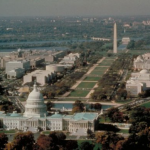Possible Research Projects
Washington DC
 Washington DC was first established on the 16th of July, 1790. It is the capital of our United States of America; some even call it the capital of the world. Its history is rich, complicated, and very interesting. As the capital of the country, it is often the center of controversy. When reading about the history of this city, three topic interested me: how the city was designed, the role of the District during the Civil War, and the impact the drug epidemic had on the city, and how it influenced the rest of the nation.
Washington DC was first established on the 16th of July, 1790. It is the capital of our United States of America; some even call it the capital of the world. Its history is rich, complicated, and very interesting. As the capital of the country, it is often the center of controversy. When reading about the history of this city, three topic interested me: how the city was designed, the role of the District during the Civil War, and the impact the drug epidemic had on the city, and how it influenced the rest of the nation.
Most great cities of the world are recognized by their sky line; tall towers of steel and concrete reaching for the sky. One of the aspects that sets Washington DC apart is its lack of a sky line. I would be interested to research why the streets were designed how they were, what symbolism exists, and why. Who designed the city, what other visionaries competed for the job, and what the city would have looked like had someone else won the job? This research could also encompass the placement and designs of the monuments that the District is famous for.
Washington DC was a city that was a proponent of the abolition of slavery. It was completely surrounded states that were pro-slavery, namely Maryland and Virginia. It would be interesting to learn what the political climate was in the District right before the civil war. Although Maryland never seceded, it still bordered Virginia. I wonder what military units were placed there, who was in charge of them, where were they stationed and what were their living conditions? I also wonder how the District was defended. What was the experience of the people of the city, did people move, and what did the people do who stayed?
On the 5th of September 1989, President George H. W. Bush addressed the nation holding a bag of crack. He told everyone that it had been purchased right across the street from the White House. He told the nation that there was a severe problem with drugs occurring across the nations. This was especially true for Washington DC. How did the presence of drugs affect the city? Did the fact that it was a problem in the city make it a priority for the federal government? What parts of the cities were most affected and why? What actions were taken by local DC government and did it work? Who were affected by the actions and how? How did it shape the future of the city? These are all questions that could be researched on the impact of drugs in DC.
In order to research these subjects, I would look at the documents and images stored at the Library of Congress. This could provide primary, as well as secondary resources. I would also try open source searches to get an initial view of each subject. I would then use JSTOR, Academic Search Complete, and other databases available through George Mason’s Library. Finally, I would also try to find published journals, books, and periodicals in the school library.

You certainly suggested three diverse topics! With all three, of course, the iterative research process will lead to to narrow them quite a bit. For the subjects where you laid out some exploratory questions, it seems as if selecting a specific time frame will be necessary.
The problem of drugs in DC will have a history dating well-before the first President Bush, and as in so many places, it brings out questions of class and race. Who was using/dealing/selling what? Where in DC? Who got caught? Who didn’t? How was the problem of drugs framed in terms of the District of Columbia? That particular topic puts you very much into local history.
There are many materials available on the creation of the District of Columbia. The book, “Washington in Maps” by Iris Miller would give you a good summary of the story. It’s in Fenwick Library.
If you chose a topic related to the environment in DC before the Civil War or any of the military history related to the Civil War, you’ll find a wealth of primary and secondary sources that we can talk about.